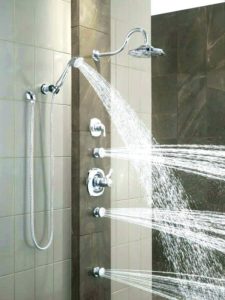
Not just going with the flow: Multi-showerhead water efficiency

![]() Showering is one of the leading uses of water inside the home, representing approximately 17 percent of annual residential indoor water use in the United States. This translates into more than 1.2 trillion gallons of water consumed each year, according to the American Water Works Association. Through its codes and standards, the International Code Council joins other organizations to help maintain water efficiency in the built environment and to attain harmonization on the use of multi-showerheads across North America.
Showering is one of the leading uses of water inside the home, representing approximately 17 percent of annual residential indoor water use in the United States. This translates into more than 1.2 trillion gallons of water consumed each year, according to the American Water Works Association. Through its codes and standards, the International Code Council joins other organizations to help maintain water efficiency in the built environment and to attain harmonization on the use of multi-showerheads across North America.
Some showerhead background
Back in 1992, under the Energy Policy and Conservation Act, all showerheads manufactured in the U.S. could have a maximum flow no greater than 2.5 gallons per minute (gpm) at a flowing water pressure of 80 pounds per square inch (psi). The intent, of course, was to save water, particularly hot water and its associated energy use.
Over the years, the showerhead trend moved toward multi-spray systems, which have up to six showerheads (each of which complies with the 2.5 gpm flow maximum) and waterfalls, which are not really showerheads and therefore are not subject to the requirement. For instance, a popular Kohler luxury shower system has eight separate showerheads, each one complying with the 2.5 gpm maximum. These multi-spray and waterfall systems can use up to 20 gallons of water per minute, just for one person. The term “showerhead” in federal regulations was understood by many manufacturers to mean a device that directs water onto a bather. Each nozzle in a shower was considered separate and in compliance if it delivered no more than the 2.5 gpm maximum.
In May of 2010, the U.S. Department of Energy (DOE) said it would adopt a strict definition of the term “showerhead” in enforcing standards that have been on the books for nearly 20 years. Under the new interpretation — a showerhead may incorporate “…one or more sprays, nozzles or openings…” — all nozzles, sprays and openings would count as a single showerhead and be deemed noncompliant if, taken together, they exceed the 2.5 gpm maximum.
The new rule affected not just upscale systems but also those with hand-held sprays used by the elderly and disabled as well as shower rooms at schools or gyms that use multiple showerheads. According to many in the plumbing products industry, only one to four percent of new homes have multiple shower head systems, but of those, some of the multiple systems are used by the elderly and disabled.
Making new sense of multiple showerheads
WaterSense is a U.S. Environmental Protection Agency (EPA) program designed to encourage water efficiency in the U.S. through the use of a special label on consumer products. Multiple showerheads are eligible to receive the WaterSense label provided “…the showerheads are sold in combination in a single device intended to be connected to a single shower outlet. Further, each showerhead must meet all of the requirements of the specification and the entire multiple-head system must meet the maximum flow rate requirement of the specification in all possible operating modes.”
The WaterSense specification applies to high-efficiency showerheads that have a maximum flow rate of 2.0 gpm or less. This represents a 20-percent reduction in showerhead flow rate over the federal standard of 2.5 gpm, resulting in a potential savings of more than 1,200 gallons per showerhead per year. In energy terms, that translates into 370 kilowatt hours of electricity annually — enough to power a house for 13 days. Through 2017, WaterSense has helped Americans save a cumulative 2.7 trillion gallons of water and more than $63.8 billion in water and energy bills.
The Code Council is a partner in the EPA’s WaterSense program and has called on the U.S. Congress to require WaterSense performance measures in infrastructure investment. Additionally, the ICC Evaluation Service (ICC-ES), a member of the ICC family of solutions, certifies product compliance to WaterSense performance criteria at no cost, in recognition of the importance of conserving water. Products and services that earn the WaterSense label with the ICC-ES certification mark are certified to be at least 20-percent more water-efficient without sacrificing performance. The Code Council also has a partnership with the Residential Energy Services Network (RESNET) in the development of the Water Efficiency Rating Index, which establishes a system to rate a home’s efficiency in water use.
Multiple showerheads in the codes
Multiple showerheads are addressed in both the International Plumbing Code (IPC) and the International Green Construction Code (IgCC). Section 604.4 (Maximum flow and water consumption) of the IPC limits an individual showerhead flow to 2.5 gpm at 80 psi, as tested by the applicable product standard. This aligns with federal law with respect to maximum allowable flow from a showerhead.
Section 601.3.2.1 (Plumbing Fixtures and Fittings) of the IgCC specifically requires compliance of showerheads with the EPA WaterSense specification of 2.0 gpm as the maximum flow rate from a showerhead. While the IgCC is silent concerning showerheads with respect to group shower areas, it limits the flow from showerheads operating simultaneously based on the floor area of the shower compartment.
Supporting indoor water efficiency
In recognition of common interests in supporting indoor water efficiency, the Alliance for Water Efficiency (AWE) and Plumbing Manufacturers International (PMI) signed a memorandum of understanding regarding multiple showerhead requirements in green codes and standards, including ASHRAE 189.1 Standard for the Design of High-Performance Green Buildings Except Low-Rise Residential Buildings (which includes content from the IgCC published by the Code Council), and the ICC 700 National Green Building Standard. The agreement supports a mutually agreed-upon technical provision pertaining to the use of multi-showerheads in shower compartments. Both organizations have agreed to work collaboratively to maintain water efficiency in the built environment and to attain broad harmonization on the use of multi-showerheads in shower compartments across North America.






